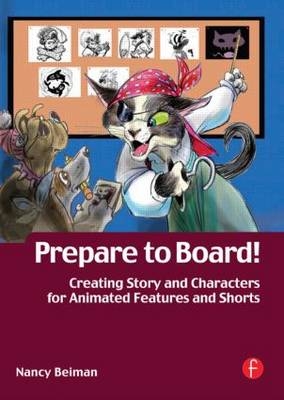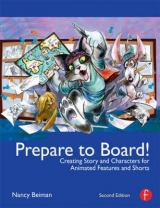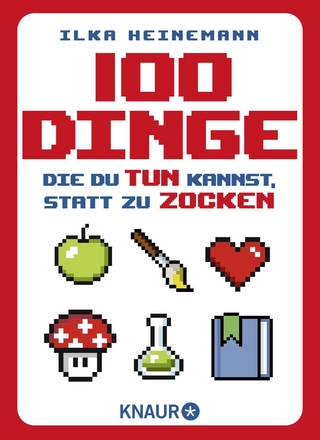
Prepare to Board! Creating Story and Characters for Animated Features and Shorts
Focal Press (Verlag)
978-0-240-80820-8 (ISBN)
- Titel erscheint in neuer Auflage
- Artikel merken
Packed with illustrations that illuminate and a text that entertains and informs, this book explains the methods and techniques of animation preproduction with a focus on story development and character design.
Story is the most important part of an animated film-and this book delivers clear direction on how animators can create characters and stories that have originality and appeal. Learn how the animation storyboard differs from live action boards and how characters must be developed simultaneously with the story. Positive and negative examples of storyboard and character design are presented and analyzed to demonstrate successful problem-solving techniques. Artwork from an international array of students and professionals supplement the author's own illustrations. Three never-before-published interviews with well known development artists and a comprehensive glossary are also included.
Currently teaching animation and character design at the Rochester Institute of Technology, Nancy has worked for nearly thirty years as a supervising animator, director, character designer, and storyboard artist. A graduate of the Character Animation Program at the California Institute of the Arts, Nancy worked in development and as a supervising animator on several Disney features including A Goofy Movie, Hercules and Treasure Planet. She was nominated for an Annie award in 2000 for storyboarding Little Angelita for Disney and won a Cine Golden Eagle in 1984 for her personal film Your Feets' Too Big. Nancy is a member of the National Cartoonists Society and the Australian Black and White Cartoonists Club. In recent years she has illustrated two children's books, Duffy and the Invisible Crocodile and Basil Bigboots the Pirate for Australian writer Patricia Bernard in 2004, and taught at the Savannah College of Art And Design. Currently teaching animation and character design at the Rochester Institute of Technology, Nancy has worked for nearly thirty years as a supervising animator, director, character designer, and storyboard artist. A graduate of the Character Animation Program at the California Institute of the Arts, Nancy worked in development and as a supervising animator on several Disney features including A Goofy Movie, Hercules and Treasure Planet. She was nominated for an Annie award in 2000 for storyboarding Little Angelita for Disney and won a Cine Golden Eagle in 1984 for her personal film Your Feets' Too Big. Nancy is a member of the National Cartoonists Society and the Australian Black and White Cartoonists Club. In recent years she has illustrated two children's books, Duffy and the Invisible Crocodile and Basil Bigboots the Pirate for Australian writer Patricia Bernard in 2004, and taught at the Savannah College of Art And Design.
0:01 Introduction and dedication
0:1.01 IT'S ALL ABOUT THE STORY. We've heard this repeated often. But why do so many animated films lack this essential quality? The book opens with an Analysis of why some films 'crash and burn' and why animated film must have stronger stories and more believable characters than live action film.
Character design is second in importance only to story in the success of an animated film. The Introduction will provide a definition of 'appeal' in animated character design: and describes why even an 'ugly' character may be appealing to a viewer if well designed.
0:1.02 A brief explanation of my background, short portraits of my friends and professors of animation to whom I would like to dedicate this book: A. Kendall O'Connor, T. Hee, Shamus Culhane, Joe Grant, Frank Thomas, and Ollie Johnston.
0:1.03 Explanation of the book's setup:
ANALYSIS OF HOW ANIMATION STORYBOARD DIFFERS FROM LIVE ACTION STORY BOARD. Live action boarding sets the stage for the characters; animation boarding creates the characters along with the stage.
Characters must be designed concurrently with storyboard and not in isolation. Therefore, the book is not divided into separate sections on story and design; the chapters are inter-cut so that the reader may see how they support and develop each other.
1:01First, Catch Your Rabbit: Getting Started in Story
1:1.01 Where Do You Get Your Ideas? Working From (your) Life); News Items; Creating extraordinary stories from ordinary materials
1:1.02 Shopping for Story: Creating Lists, Characteristics and props to provide ideas
1:1.03 What If? Crazy Problems and Sane Solutouns. Free association and word play create story.
1:1.04 This Kangaroo Walks Into a Bar: Situations and Character Driven Film.
The two major types of animated films: strengths and
weaknesses of historic examples.
1:1.05 Squaring the circle: Blocking in rough characters and the meaning of shapes; why your friend may be a real square; how a triangular guy points things out, and how a circle can help you get around; how Scale of the characters and props can change the story.
1:1.06 Location, Location, Location: Unusual settings for your story. Period pieces and settings. How to turn clichés on their heads in production design.
1:02 From Treatment to Boards: The Visual Perspective on Animated Story
1:2.01 The Old Fashioned Way: Working with TreatmentsSome examples of films made without
Scripts. How to write a simple treatment.
1:2.02 Found in Translation: Adapting other media
for Motion Pictures. Interpreting visuals from verbal cues. Editing the Material. Examples of successful and unsuccessful adaptations.
1:03 In My End Is My Beginning: Why Mary Queen of Scots had the Right Idea about Story
1:3.01 Strong to the Finish: Why it's important to know your ending BEFORE you start. Knowing where you and your story are going.
1:3.02 The Tex Avery Twist: Creating Memorable and
Unusual Endings
1:3.03 Where You're Coming From: Beginning the Story. Get to the beginning: Introduce your
characters and situations and create audience interest.
1:3.04 Conflict with Interest: Develop the Situation
"Get your hero up a tree. Throw rocks at him.
Developing conflict and building the pace of the film.
1:3.05 Planning Sequences: Definitions of sequences, with examples. Fantasies, Dreams, and Plain Storytelling.
2.01 TELL ME A MOVIE: Beginning Storyboard and Character Design
2:1.01 THE SHAPE OF THINGS: Creating
a Contrast in your Character's Design
Silhouette value. When and how to research styles of Illustration and design. Frank Thomas' rules for Research. PERIOD SILHOUETTES.
2:1.02 CARICATURE: Putting Yourself (and your Friends, and your Sketchbook) Into Your Work
WHY it is CRUCIAL to keep a sketch book. Humans, animals, vegetables, and minerals. Listing Character traits and interpreting them visually. How a name can help you devise a personality.
2:1.03 Like Nothing Else Ever Seen Before: Creating Fantastic Characters from Parts You May Find Lying Around Your Reference Library. Avoiding Stylistic Clichés.
2:1.04 Beat Me Daddy, Eight to the Bar: Beat Boards: working out the structural
emphases of your story; major turning points.
2:1.05 Color My World: The Use of Color in storytelling. Animated films were using color as emotional indicators years before live action pictures did. Why they still do it best. Color Storyboard planning. Examples of color keys and boards.
2:1.06 A TREE IS A TREE: Researching Backgrounds,
Settings and Art Direction Styles. Creating a world.
Master backgrounds and floor plans.
2:1.07 ROUGHING IT. Thumbnails and the First Pass. Working out the action in a sequence BEFORE
you break it down into scenes. Be aware of what
comes before and after your sequence!
2:1.08 READING THE BOARDS: How to Make Sure
that your boards are clear and easy to see: The Four Values; using tone to set the mood and tell the story; The Fifteen Foot Rule. Designing your Frames.
2:1.09 Step Up to the Pitch: Presenting your First Boards to a Critical Audience (yourself included); Ollie Johnston's Ten Second Rule.
2:1.10 The More Things Change: The Turnover Session. How to Stage A Storyboard "Jam Session.
Where no story or gag idea is too bizarre or off-key. Utilizing and Accepting Suggestions for change.
3:01 LOCKING IT DOWN: Creating Presentation Boards and Model Sheets
3:1.01 Refining your boards. Emphasizing contrasts and working for the clearest possible staging.
3:1.02 Music Hath Charms. Setting the story with music. Reading dialogue and Slugging boards. Rough timing. Using a scratch track.
3:1.03 Build a Better Mouse: Construction Models and Planning Characters' Mobility in the design phase. Why it is vitally important to work it out on
Paper FIRST, especially if you are working in CGI.
3:1.04 Diamond in the Rough Model Sheet: Working to see that your characters have a stylistic resemblance, are from the same 'universe'.
Comparative model sheets, designing characters
and props together.
3:1.05 Creating the "Bible. How a television series' characters are developed; designing lineups, turnarounds, and props. Creation of a model pack. Why television production differs from that of a short or feature film.
3:1.06 A Moving Experience: Testing Your Designs
Creating action poses and Test Animation. Simplifying the Design and evolving shapes. Creating typical facial expressions for CGI blendshapes and stop motion.
3:1.07 AM I BLUE?: Color Models for Character Moods and Situations. Why the colors may change
depending on the location, emotion, and story point.
3:1.08 It's a Setup: Placing Your Characters over
the Background. Designing characters poses with
background; avoidance of Tangents.
3:1.09 Maquette Simple: Sculpting the Design
A real '3d' version of your character will help
you see what angles suit it best. Creating a CGI
or puppet model based on your maquette. Modeling poses and developing a skeleton that works with your design.
3:02: THE FINISHING TOUCHES: CREATING AN ANIMATIC OR STORY REEL
3:2.01 Screen and Screen Again: Creating Story Reels and Animatics. Computer editing systems and the use of simple motion on a storyboard panel. Test Screenings. The use of sound effects and editing. Pop Thrus and Previz for CGI and puppet films.
An' dat's de end: An afterword
PART 4:APPENDIX
4:01 INTERVIEW with A. Kendall O'Connor , art director and board artist, FANTASIA, PINOCCHIO, DUMBO, LADY AND THE TRAMP.
4:02 INTERVIEW with Ken Anderson, art director,
101 DALMATIANS, JUNGLE BOOK
4:03 INTERVIEW with T. Hee, Caricturist and director, DANCE OF THE HOURS, PINOCCHIO
| Erscheint lt. Verlag | 7.3.2007 |
|---|---|
| Verlagsort | Oxford |
| Sprache | englisch |
| Maße | 178 x 254 mm |
| Gewicht | 872 g |
| Themenwelt | Literatur ► Comic / Humor / Manga |
| Kunst / Musik / Theater | |
| Mathematik / Informatik ► Informatik | |
| ISBN-10 | 0-240-80820-7 / 0240808207 |
| ISBN-13 | 978-0-240-80820-8 / 9780240808208 |
| Zustand | Neuware |
| Informationen gemäß Produktsicherheitsverordnung (GPSR) | |
| Haben Sie eine Frage zum Produkt? |
aus dem Bereich



